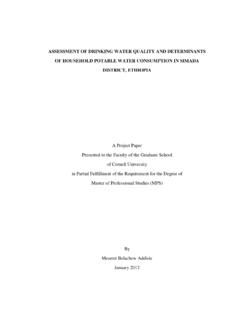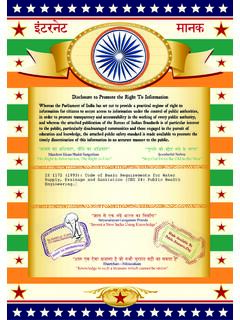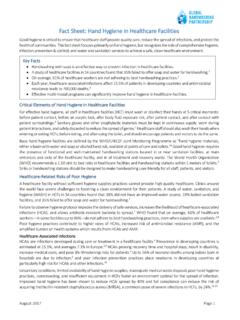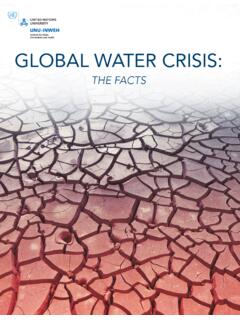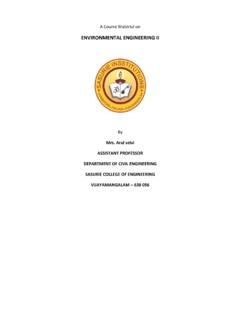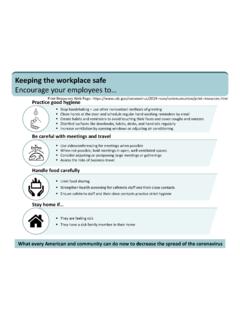Transcription of Assessment of Water Supply and Sanitation in Amhara …
1 MAIN DOCUMENT Assessment of Water Supply and Sanitation in Amhara Region Seifu A. Tilahun, Amy S. Collick, Manyahlshal Ayele Learning and Communication Research Report This research document is prepared by Seifu A Tilahun: Lecturer at School of Civil and Water Resources Engineering of Bahir Dar University Dr. Amy S Collick: Assistant Professor of Civil and Water Resources Engineering of Bahir Dar University and Post Doctoral Associate of Cornell University, USA Manyahlshal Ayele: Learning and Communication, WaterAid, Addis Ababa Ethiopia This research document was the result of a project of Learning and Communication of Water Supply , Sanitation and Hygiene (WaSH) of Amhara region which was financed by Water Aid Ethiopia. The following people were the research team members from the school of Civil & Water Resources engineering that helped with data collection from 32 sites: Atikelte Abebe, Abeyou Wale, Chalachew Abebe, Elias Sime, Essayas Kaba, Mengiste Abate, Seifu Admassu, Temesgen Enku, Tammo Steenhuis Declaration The ideas and opinions presented in this report are those of the authors and do not necessarily reflect the view of Bahir Dar University.
2 Citation WaterAid Ethiopia and Bahir Dar University encourages fair use of this document with proper citation. Please use the following for citation: Seifu A Tilahun, Amy S. Collick and Manyahlshal Ayele. 2012. Water Supply and Sanitation in Amhara Region. Learning and Communication Research Report, Bahir Dar, Ethiopia Cover photograph shows small girls fetching Water from hand pump fitted hand dug well at Ermito locality in Enbese Sar Medir woreda of E. Gojam Zone, Ethiopia (photo credit: Mewael Gebregiorgis, 2010 ) Please send inquiries and comments to: and EXECUTIVE SUMMARY Great effort has been put forth to increase the number of people with access to safe Water Supply , adequate Sanitation and effective hygiene in the developing world. However, the issues and factors of sustainability of these services are just as important and not documented very well. WaterAid has made an effort to address the challenges of sustainability by funding a project to improve the documentation of the conditions and status of 32 localities in which Water , Sanitation and Hygiene (WaSH) schemes have been implemented throughout the Amhara Region.
3 These 32 WaSH schemes have been investigated by using physical observation and checklist interviews conducted with communities, Water user committees and woreda experts. Additional information was gathered through the review of five Cornell-BDU master theses concerning rural Water Supply and Sanitation and their factors of sustainability. The findings showed that the idea of simple technology is not always a solution as two different communities (Kule and Awera Amba localities) have been able to manage for long period of time a borehole equipped with a diesel pump. However, they have encountered the major challenge of the high cost of fuel to run the diesel. In this study, it is shown that pumps powered by solar panesl can be an alternative technology in such cases where the sites are far from the electric grid system. The simple technologies such as hand pump fitted on hand dug well works well in areas where there is no alternative Water Supply sources as shown in Enbes Sar Mider locality and in areas where springs can be developed for multiple use of Water (cattle trough and irrigation).
4 The sustainability of developed Water Supply sources is often dependent on the existence of alternative Water Supply sources. In areas where there are a sufficient number of alternative sources, the strategy should be to develop the Water point most preferred by the community, or to direct efforts towards household provision of Water rather than a communal Water point. Otherwise, the communities would not buy into the operation and maintenance since their preferred Water source remains undeveloped but free of charge to use. The most common challenges observed at the study sites were (1) collected fees paid for maintenance only, (2) confusion about the management prevailed where there were different types of users and (3) conflict often raged between users and farmer who owned the land on which the scheme was constructed. In such cases, more complete community participation and awareness and implementation of multiple uses at a Water scheme are better approaches and lead to potential solutions of these challenges.
5 Finally, Sanitation and hygiene practices are observed to be low. In most cases, the latrines have little or no walls or roofs and are not suitable for people who are disabled. Those households reported to have latrines are in most cases not the actual users of the latrine or the hand washing facilities. Reasons for not using latrines were found to be the additional work to dig a hole was excessive, the latrine was not able to be used during the summer due to runoff, the location at the homestead was far from the users agricultural land where they worked for most of the day and many more. Furthermore, it is important to evaluate the impact of current Sanitation and hygiene practices on the Water quality of the Water sources and domestic Water at individual households and on the overall health of the community. iv ACKNOWLEDGEMENTS We would like to express our sincere appreciation to all the people and organizations at the regional level, such as Amhara Bureau of Water Resources Development, at the zonal and woreda levels, such as the branch offices of the Regional Bureaus, NGO s (ORDA, RWSEP-Finida, CARE-South Gonder, and UNICF) and all the schemes communities and Water user committees for giving their precious time to share knowledge, experience and information about Water Supply and Sanitation .
6 We also greatly appreciate the efforts taken by all project team members (Atikelte Abebe, Abeyou Wale, Chalachew Abebe, Elias Sime, Essayas Kaba, Mengiste Abate, and Temesgen Enku) of the School of Civil and Water Resources Engineering to coordinate and facilitate all research activities from inception to completion of the project and this report. We are thankful to the financial, transportation, procurement and other university administrative offices for making this project possible. We are very grateful to Prof Tammo Steenhuis for his advisory role and to Cornell graduate students for sharing their documentation and data of the Water Supply and Sanitation projects in their research areas. We also would like to extend our appreciation to Michael Assefa, Mewale Gebregiorgis, Teshale Tadesse and Wondimu Paulos for their photography collection, data collection and Water quality analysis on the field.
7 Finally, we are grateful to WaterAid for their financial and advisory support to conduct such a meaningful project. v TABLE OF CONTENTS Table of contents .. v List of Figures .. vii List of Tables .. ix 1 Introduction .. 1 2 Objectives .. 4 3 Significance of the Project .. 5 4 Site Description of Selected WaSH Schemes .. 6 5 Methodology .. 10 6 Technology .. 13 Spring .. 13 Hand dug well .. 14 Shallow well and Borehole .. 16 Hand Pumps .. 16 Diesel 18 Solar Driven pump .. 19 History and description of the solar powered schemes .. 21 Current status .. 21 Points to be considered .. 23 Recommendations .. 24 7 Operation and Maintenance .. 26 Definition of Terms .. 27 Cash contribution for operation and maintenance .. 29 Safeguarding the Water source .. 29 Alternative sources .. 30 Trainings on maintenance .. 31 Recommendations .. 33 8 Multiple use of Water .
8 36 Background .. 36 vi Conditions for MUS .. 37 MUS at the onset .. 39 Upgrading the existing system to MUS .. 40 Pitfalls of lack of 41 Recommendations .. 42 9 Sanitation and Hygiene .. 44 Background .. 44 Hygienic practices .. 47 Latrine coverage and use .. 48 Promotion of Sanitation .. 50 Type of Latrines .. 51 Cover for latrine hole .. 51 Water Quality Anaalysis .. 52 Recommendations .. 55 10 Administration of schemes .. 57 Background .. 57 Non-functionality .. 58 Community Participation .. 59 Water user 61 Recommendations .. 62 References .. 64 vii LIST OF FIGURES Figure 4-1: Location of 32 WaSH schemes in 31 woredas and five woredas studied by Cornell-BDU MPS students throughout the Amhara Region .. 7 Figure 6-1: Excavation and installation of lining procedure of hand dug well below the ground Water level (Source: WaterAid, 2011).
9 15 Figure 6-2: Diesel motor powering pump in the borehole (at the left) and borehole source site and power house (right) of Kule, Harbu, N Wolo (Photo by: Teshale T, 2011) .. 19 Figure 6-3: Location map of solar powered shallow well in this research project .. 20 Figure 6-4: Failed solar powered Water Supply scheme due to pump at Abate Barage locality of Fogera Woreda in S. Gonder (photo by Michael A. 2011) .. 22 Figure 6-5: Functional (with major disrepair) solar powered shallow well Water Supply system at Yebabe Eyesus, Bahir dar Zuria (Photo by: Teshale T, 2011) .. 22 Figure 7-1: Location map of Water points monitored in this study (Map by: Seifu A., 2011) .. 27 Figure 7-2: Type of Water source used before the developed scheme in Mecha woreda .. 31 Figure 7-3: Missing faucets and other disrepair make the Water point at the Gafate locality (W. Este) inoperable (Photo by: Meserte B.)
10 , 2010) .. 33 Figure 7-4: Damaged hand pump at Manayita locality, Sekela, not an easy repair (photo byWondimu P, 2010) .. 33 Figure 8-1: Location map of Water points monitored in this study (Map by: Seifu A., 2011) .. 37 Figure 8-2: Functional MUS spring at Degameske locality of Yilmana Dense Woreda (Photo by: Teshale T., 2010) .. 39 Figure 8-3: Irrigation canal and shower (A) provided at a poorly implemented gravity spring scheme (B) at Tigo spring in Tehuledere Woreda (Photo by: Wondimu P., 2011) .. 40 Figure 9-1: Location map of Water points monitored in this study (Map by: Seifu A., 2011) .. 45 Figure 9-2: Never used hand wash facility at Saye Meskel locality of Mojana Woreda N. Shewa Zone (Photo by: Michael A., 2011) .. 47 Figure 9-3: Solid waste management system at Awora Amba locality of Fogera Woreda, S. Gonder Zone (left) liquid waste pit at Kaba Locality of Menth Mama woreda of N Shewa Zone (Photo by: Teshale T.


